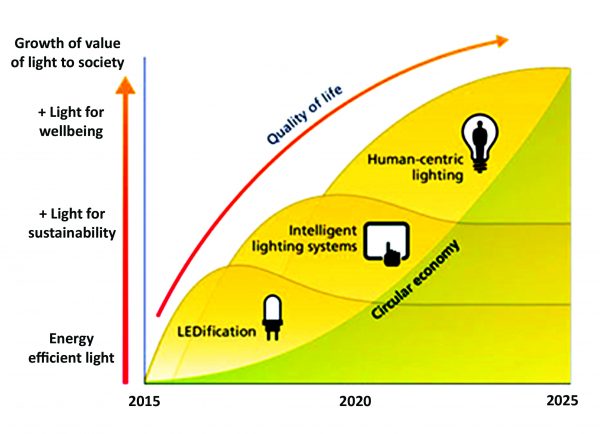We may not realize but the light has a great effect on us. Not only does it allow us to see, light stimulates us and influences our moods and activity levels. Science has proved that our physiological response to light varies depending on its color spectrum, intensity, and timing. Because of this sensitivity to light, the characteristics of the artificial light in our surroundings also becomes important, especially if we spend a lot of time indoors.
HCL (or Human Centric Lighting) refers to lighting solutions which are designed based on new knowledge on the biological effects of light.
With the emergence of HCL-based solutions and the introduction of LEDs, a radically new approach to lighting is possible. With new technology, tunable white light can be achieved in an energy-efficient manner. It can even be controlled easily with advanced control systems. These newer, smarter, connected lighting systems create endless possibilities with better user control and environmental customization.

But before we dive in too deep…
What exactly does HCL mean?
Put simply, Human Centric Lighting (HCL) is a Lighting solution designed to support the human circadian rhythm, enhance concentration, reduce stress levels and prevent sleeping disorders.
HCL is a concept devoted to enhancing vision, wellbeing, and performance. It can make any space more comfortable and efficient for working and improving the quality of life by using LED design and control.
The circadian rhythm of our bodies refers to physical, mental, and behavioral changes that follow a daily cycle. Sleeping at night and being awake during the day is an example of a light-related circadian rhythm.
Circadian lighting or human-centric lighting (HCL) is a strategy that takes into account the circadian rhythm. Circadian lighting systems are designed to be able to control the intensity and color of the light, with feedback from the illuminated space.
LED-based human-centric lighting is controllable and tunable across a spectrum of correlated color temperatures (CCTs). It helps evoke particular human biological responses and behavior in well-designed indoor environments.
For example:

But no one complains about light in their workplace…
People do not complain generally due to a lack of awareness about the impact of poor lighting on their body. They are usually unable to correlate it to their sleeping disorders. Complaints about lighting are more common when the light levels are low or when the light sources cause discomfort glare. It is easier for most of us to identify these light conditions since the problems can lead to headaches, neck or back pains, general fatigue and fatigue in the eye muscles.
Positive non-visual effects of good lighting
When the lighting in your environment is designed along with HCL principles, you can certainly experience several non-visual benefits.
For example,
- Short-term bursts of cool white and intensive light may help increase your concentration, almost without you knowing it.
- It might even make you feel sleepier at night because the lighting has shifted your daily rhythm a bit.
Both these are examples of positive effects that you perhaps do not notice immediately, or at all.
Who can benefit from HCL?
As stated earlier, HCL can be very beneficial for anyone who spends most of the day indoors. This includes school children, office workers, elderly people with dementia, shift workers etc.
Long-term benefits of HCL will look somewhat like this:

Advantages in offices and workspaces: HCL has visual benefits in environments where luminaires are installed. This kind of lighting not only refines the space but also creates tangible ways of providing more comfortable and customizable atmospheres within buildings.
In office spaces, neutral to cool color temperatures (3000-4000K) are generally appropriate and work best for the employees. This can vary on other types of work environments.
Advantages in hospitals: Healthcare facilities are using HCL to add cooler CCTs in staff areas to keep employees alert during shifts, while also using warmer CCTs in the patient rooms to keep individuals comfortable as they rest and recover.
Color temperatures between 3500K to 5000K are good for setting a clean atmosphere and creating alertness in a hospital.
Advantages in schools: Schools utilize HCL to both calm students and to keep them alert depending on the time of day. Appropriate lighting can make the environment feel more natural and comfortable for children while improving their productivity and retention.
In order to set an energetic atmosphere, cooler color temperatures between 3500-5000K are good. These temperatures even have the capability to promote alertness.
For more information on world-class lighting Solutions
Contact Actis at 022-30808052 or at contact@actis.co.in.


